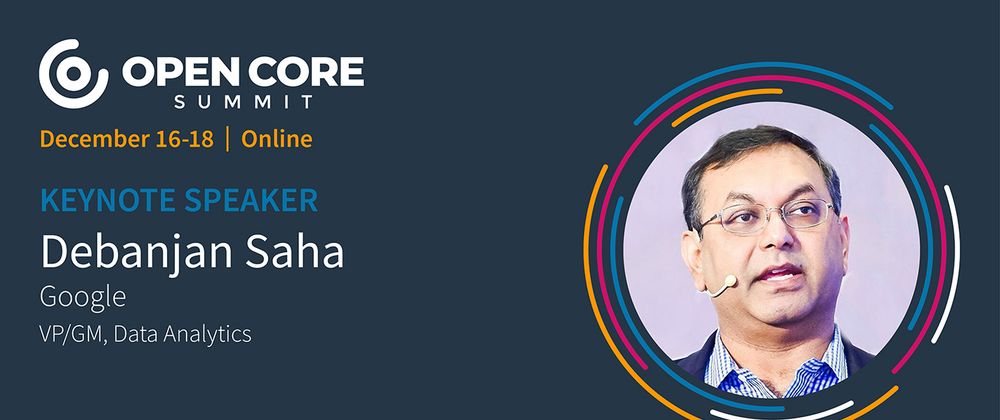Debanjan Saha is the GM of Google Cloud and VP/GM of Data Analytics at Google. He is also an innovator, author, and IEEE fellow.
Relevant Links
LinkedIn - Twitter
JJ interviews Google Cloud GM Debanjan Saha on why Open Cloud is core to Google Cloud's strategy.
From your perspective, what is so attractive about open source? How do you look at it? — 00:09
Debanjan highlights (1) the participation of the community, and the resulting rate of innovation, (2) open source’s effect on the cost of software, making software free for many people in comparison to enterprise, which democratized use of software, (3) portability, (4) open data in addition to open source code, (5) inspectability and its importance to customers.
In addition to what Google is doing on cloud, you’ve been a great partner in the COSS ecosystem. Can you talk about examples of your work with different vendors in that ecosystem? — 2:05
Debanjan highlights partners including Confluent, Databricks, Neo4J, Elastic. “Any managed open-source vendor, we work with them.”
Can you talk about the history of Google and open source? — 3:06
“Google is a company that really cares about doing the right thing for the developer community.”
Debanjan speaks about software developed entirely for Google, which the company chose later to open source.
Debanjan also details the commercial perspective, and customer interest in open source.
Debanjan speaks about how cloud has made management easier for open source software, and opened the door to adoption of OSS in enterprise companies.
Debanjan also mentions that, in cases where cloud-native software is difficult to open source, Google tries to utilize open APIs so that users can move to that software stack or move out. Highlights importance of open APIs and open data in addition to open source.
When you’re making a product decision, what factors are an input into whether Google produces something as an open source or open API, versus a fully proprietary service? — 5:50
Debanjan speaks about his interest in open APIs and elaborates on the business case for it, focusing on ease of migration and adoption.
“That is top of my priority list, when you think about a new service, what is the API you are going to build?”
How do you think about data gravity in terms of deciding between open API vs. open source vs. proprietary? — 8:02
More than open API, Debanjan highlights the importance of open data format, so users and customers can keep their options open.
“If you can create a federated system, where you can take your analytics wherever your data is … it becomes a lot more powerful, and from the business and management perspective, people love that.”
What are the most exciting observations and evolutions in data, from Google’s R&D lens? — 10:10
Debanjan highlights open as one of the most important trends here to stay — open software, open APIs, open to partners — and flexibility.
Debanjan also speaks about the beginning of “Gen 3” cloud, which will be around data analytics and AI/ML. “People want their insights to be available in real-time. … Real-time is becoming really really important. … They want to look around the corner to see what’s next, and that’s where the augmented data grows. You are looking at the data you have, building these models as quickly as you can, and using these models to predict what’s next. And that’s where you’re going to see a lot of invention and innovation. And that’s going to happen everywhere in the stack. It could be at the hardware layers, with the GPUs and the CPUs … it’s going to be in the distributed systems layer … and it’s going to be in the inside layer. …. How do you democratize this massive power of AI and analytics to everybody? What I would like to do, what Google would like to do, is make it available for everybody.”
Debanjan elaborates with BigQuery, how Google is building an Excel interface to make the tool accessible to those who don’t know SQL. “We want to take it one step further … building an NLP on top of your data, so you can actually talk to your data as if you’re writing a search query. That is the vision we’re after.”
You see a future, where there’s going to be a human conversational element with big data, almost natural language for replacing highly complex queries? — 14:59
“Absolutely, and I see that today by the way. We do have bigQuery our data Q&A running in preview and I see people using this. If you take a step back and look at Google’s history, the most simple user interface I have seen for a complex computing system is the search bar. … It almost reads your mind in terms of what you are looking for.” Debanjan elaborates on what’s behind the search bar, and applies that to the context of data analytics.
Debanjan explains the impact of making analytics accessible to ordinary business users, through natural language processing and conversational queries.
How do you see the evolution of cloud computing in the context of open source, from different origination sources? (ex. Google, individuals, academies, other multinational organizations) — 17:14
Debanjan speaks about how cloud computing has made it easier for people to build products and take them to the whole world. “Scaling that to a massive user base, cloud has made it possible.” Debanjan elaborates on the network effects of cloud.
“What cloud has also made possible, open source in many ways was very special and dedicated people making it happen. Making it commercial was hard. .... Cloud has really made it possible. So it’s on both sides. Creators of open source can make it available and quickly commercialize and make it a viable business. That is the power of cloud, that is helping open source grow like nothing before.”
What piece of advice you’d give to current and next generation of entrepreneurs about best engaging with the cloud, best engaging with Google, and how Google can help them in their entrepreneurial journey? — 20:15
“Any time you want to make something successful commercially, you have to start with a customer and a customer problem. If you start with a customer and a customer problem and walk backwards from there, and build something that is useful in solving a boring problem or solving a challenging problem, you can find a way to make it commercially successful.”
“The value of cloud is you can take big risks, and you can reduce the risk of failure, or minimize the cost of failure. … You don’t need to build an infrastructure, you can move from one project to another, you can do large-scale experiments, you can reach out to a wide audience. … If you have a bright idea, if you know a customer, if you can figure out how to solve a customer problem, you can really scale it well with the cloud infrastructure and the cloud provider. We at Google are always looking for those bright ideas, because that often comes from people in different walks of life, not always within the company, and we’re very supportive of that both in terms of supporting the developers and the entrepreneurs with various different kinds of funding and support, and commercially supporting them so they can build their stack on Google Cloud or anywhere else. … So we are really excited about open source, we really embrace the notion of open source and how we can make it successful, with our own innovation and that of the whole community.”
Share your questions and comments below!



Top comments (0)